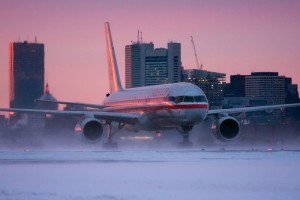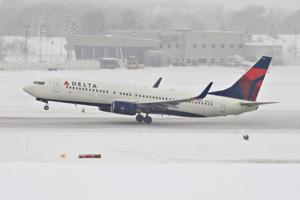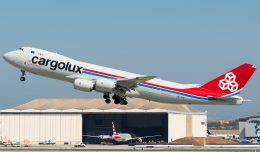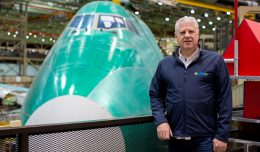Imagine this scene: You are in your living room in a quiet suburb with your friends and family on a cold winter’s night enjoying great company as a light snowfall gently coats the tree branches outside. As you relax and digest your delicious dinner you glance outside and see the roads covered up completely with snow and think to yourself, “what a lovely and peaceful sight.”

American 757 braving dusty snow in Boston. (Photo by Ron Stella)
Back to reality. All is not peaceful everywhere. As your quiet little town tucks itself into bed under warm blankets, the heat is also being turned up under the collars of those stressed out travelers trying to escape the city that night. The international airport by now is past the point of no return and the terminals are awash with delayed, cancelled and frustrated passengers who must now deal with the headaches that winter travel can offer.
When people travel by air, they are not only buying a plane ticket, but a lottery ticket. Will they win a beautiful day offering nothing but blue skies and tailwinds? Or, will they lose the jackpot and end up traveling on a day when Mother Nature unleashes her fury on the airways in the form of blizzards, icing or thunderstorms? This is not to say that losing the jackpot results in danger or unsafe situations, but it does typically result in massive delays, flight cancellations and all around angst for those paying good money to travel near and far.
On nights such as this, the main culprits are the wintry conditions that just don’t help to keep the airline system ticking along like a well-oiled machine. Just as you would wipe the snow off your car in the morning and drive slowly on an ice-slicked road, the crews flying your flight do their version of the same. When the snow is falling it takes a combination of two separate deicing mixtures to clean the wings of the aircraft. One type (known as Type 1) is a hot liquid that is used to literally de-ice the wings, tail and fuselage. The next application is a cold, jelly like substance (referred to as Type 4), which is left on the wings to catch the falling precipitation. As the aircraft speeds down the runway, the Type 4 fluid flies off the wing as it increases in speed, leaving a wing that is free of snow or ice as it launches into the air. The upside to this process is that it allows the airline to continue operations even in winter weather conditions, albeit at a much slower pace. The downside is that it takes some time to apply the fluid, it takes time to coordinate the order of which airplanes will be de-iced, and then finally an airplane has a limited amount of time to get in the air before the de-ice fluid loses its effectiveness. Once you run out of time, if it is still snowing guess what? Back for more de-icing!

Plowing away. (Photo by Zee71)
Not only do the airplanes need to be free of ice and snow, so do the runways. Most large airports have fleets of snowplows that are constantly cleaning off alternate runways during blizzard conditions. In addition, many treat the runways with chemicals that prevent the buildup of snow and ice, as well as laying down a coating of sand to increase traction for landing aircraft. The delays can buildup heavily though, in the air as well as on the ground. It is very common to be told to expect to hold for runway plowing when flying into a busy airport on an ugly night. Most of the time, as long as the forecast is relatively accurate, flight crews can plan for these delays and carry extra fuel depending on the load they are carrying. The temperature in the cockpit can rise rapidly when the forecast isn’t as planned and a crew is caught out with deteriorating weather and an inadequate amount of fuel to hold for extended delays! An early diversion to an alternate airport that only compounds the delay is typically on the agenda when this situation presents itself. These diversions can open up an entirely new can of worms for the passengers. In most cases, a flight refuels and continues to the destination, but about 1% of the time, a flight will become stranded for hours and hours and of course the media picks up on it. These incredibly long delays are typically the result of a huge breakdown in communication and inadequate staffing and services available at the suddenly overwhelmed alternate airport. These are not the norm and are the end results of a perfect storm of problems. A recent jetBlue pilot was caught on audio venting his frustration during a very long delay. We really hate to see these problems as much as the passengers!
Back in the terminal as passengers start to worry about missed connections and cancellations, the gate agents begin the ritual onslaught of aggravation that they are to deal with as they re-book and re-route these unfortunate lottery losers. As flight crews, we generally feel badly about travel plans that get interrupted by Mother Nature but ultimately the root cause of the delays are the result of doing things that are in place to ensure that each flight is flown as safely as possible. Each and every pilot’s livelihood is dependent on their customer’s satisfaction so when the customers are unhappy we are not pleased.

A Delta 737-800 rotating on departure at MSP in wintry weather. (Photo by JDANDO)
Typically on nights like these, the cockpit is a very busy place. The crew is determining the rate of precipitation and the outside temperature to determine the type of de-icing that they will need. They are estimating the excess time that will be spent on the ground taxiing as well as in the air holding at the destination to come up with an appropriate amount of fuel to carry. At the same time, they must carefully balance the weight of the passengers and cargo with the amount of fuel required to ensure that the aircraft is not out of weight and balance limits. They are constantly taking that information and entering it into the performance computers to determine that they will be able to takeoff from the runways in use as well as being able to stop on that same slick surface in the event of a problem on the runway such as an engine failure.
Taxiing an aircraft in such conditions can present an unbelievably challenging task. In a three hundred ton B747-400, it doesn’t take much to have the nose tires begin to skid on a turn taken a little too tightly. Slow and very steady wins this race every time on a slick taxi out. Ultimately, once the airplane has been loaded, pushed back, and de-iced, the flight typically progresses like any other. It’s just the three hour delay that the airplane incurred getting to the takeoff point that drives everybody nuts from the ticket paying passengers to the pilots that will wing them to their destination just as quickly as they can!
NYCAviation Columnist Justin Schlechter is a First Officer for an international airline and lives with his family on Long Island, New York. You can read more of his writing on his Positive Rate blog.







